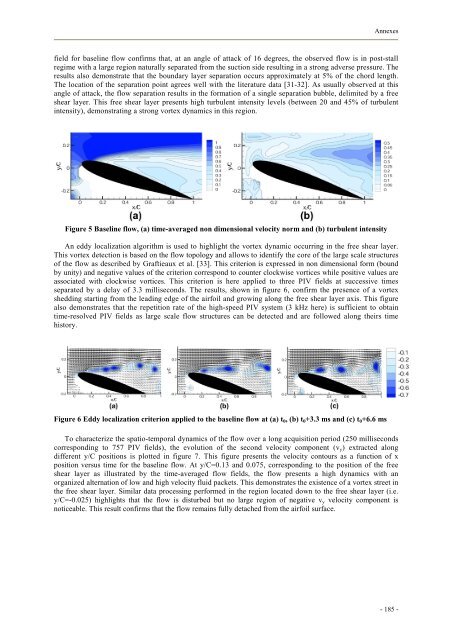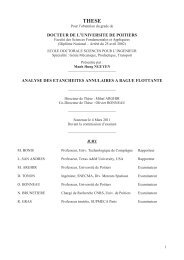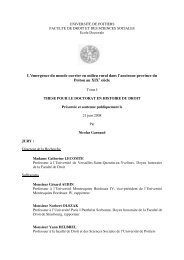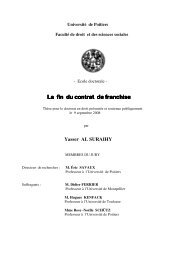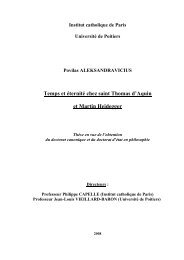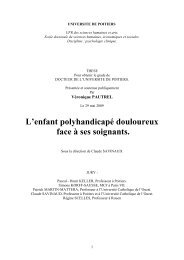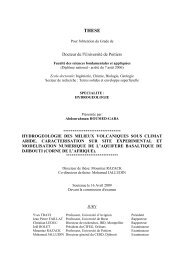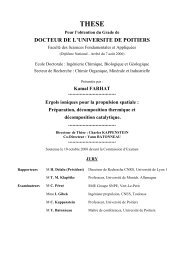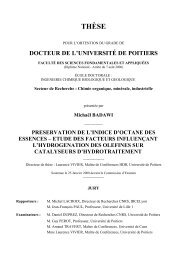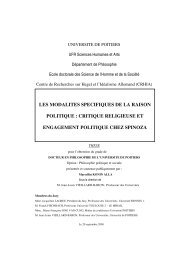Etude et développement d'un actionneur plasma à décharge à ...
Etude et développement d'un actionneur plasma à décharge à ...
Etude et développement d'un actionneur plasma à décharge à ...
Create successful ePaper yourself
Turn your PDF publications into a flip-book with our unique Google optimized e-Paper software.
Annexes<br />
field for baseline flow confirms that, at an angle of attack of 16 degrees, the observed flow is in post-stall<br />
regime with a large region naturally separated from the suction side resulting in a strong adverse pressure. The<br />
results also demonstrate that the boundary layer separation occurs approximately at 5% of the chord length.<br />
The location of the separation point agrees well with the literature data [31-32]. As usually observed at this<br />
angle of attack, the flow separation results in the formation of a single separation bubble, delimited by a free<br />
shear layer. This free shear layer presents high turbulent intensity levels (b<strong>et</strong>ween 20 and 45% of turbulent<br />
intensity), demonstrating a strong vortex dynamics in this region.<br />
Figure 5 Baseline flow, (a) time-averaged non dimensional velocity norm and (b) turbulent intensity<br />
An eddy localization algorithm is used to highlight the vortex dynamic occurring in the free shear layer.<br />
This vortex d<strong>et</strong>ection is based on the flow topology and allows to identify the core of the large scale structures<br />
of the flow as described by Graftieaux <strong>et</strong> al. [33]. This criterion is expressed in non dimensional form (bound<br />
by unity) and negative values of the criterion correspond to counter clockwise vortices while positive values are<br />
associated with clockwise vortices. This criterion is here applied to three PIV fields at successive times<br />
separated by a delay of 3.3 milliseconds. The results, shown in figure 6, confirm the presence of a vortex<br />
shedding starting from the leading edge of the airfoil and growing along the free shear layer axis. This figure<br />
also demonstrates that the rep<strong>et</strong>ition rate of the high-speed PIV system (3 kHz here) is sufficient to obtain<br />
time-resolved PIV fields as large scale flow structures can be d<strong>et</strong>ected and are followed along theirs time<br />
history.<br />
Figure 6 Eddy localization criterion applied to the baseline flow at (a) t0, (b) t0+3.3 ms and (c) t0+6.6 ms<br />
To characterize the spatio-temporal dynamics of the flow over a long acquisition period (250 milliseconds<br />
corresponding to 757 PIV fields), the evolution of the second velocity component (vy) extracted along<br />
different y/C positions is plotted in figure 7. This figure presents the velocity contours as a function of x<br />
position versus time for the baseline flow. At y/C=0.13 and 0.075, corresponding to the position of the free<br />
shear layer as illustrated by the time-averaged flow fields, the flow presents a high dynamics with an<br />
organized alternation of low and high velocity fluid pack<strong>et</strong>s. This demonstrates the existence of a vortex stre<strong>et</strong> in<br />
the free shear layer. Similar data processing performed in the region located down to the free shear layer (i.e.<br />
y/C=-0.025) highlights that the flow is disturbed but no large region of negative vy velocity component is<br />
noticeable. This result confirms that the flow remains fully d<strong>et</strong>ached from the airfoil surface.<br />
- 185 -


